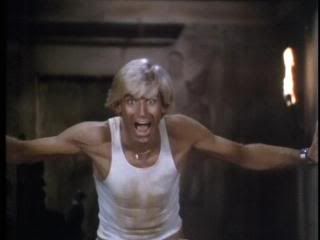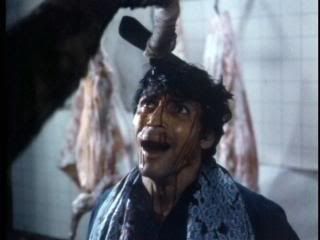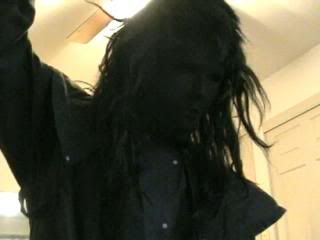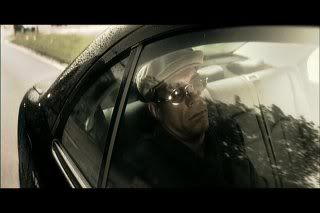
It would be foolish to suggest that a commentator of any sort isn't influenced by his or her recent experiences. I could never pretend to be completely unbiased, and with every review I do comes a lifetime of experience that is very specific to me. To that end, the films I watch have to be held to slightly different standards depending on their purpose for existing. I watched Frank Agrama's Dawn Of The Mummy with different eyes than I watched, say, I Dream Of Dracula or certainly a recent summer blockbuster like Terminator: Salvation or Star Trek, and this is out of necessity. The sort of person that would watch a film called Dawn Of The Mummy has likely already adjusted their expectations appropriately, and it's only fair that I do the same.
And Dawn Of The Mummy is an interesting animal. Obviously influenced by the Italian Dawn Of The Dead rips like Zombie and Night Of The Zombies, as well as Romero's originals, Agrama uses all of the traditional traits of mummy films; the Mummy's curse, Grave robbers, and the shambling, shuffling title creature; and combines them with the traits of late 70s/80s zombie films; cannibalism, a remote location, and buckets of gore; and transposes the whole mess to Egypt. The location filming is actually quite impressive, and there's a certain majesty to knowing that the pyramids in the background are legitimate, giving the whole production a bit of a unique look and feel.
It's a shame then that the whole thing is a tired, slow-moving mess. The characters are almost wholly unsympathetic, and often totally unlikeable, and seem to exist solely to be fodder for the Mummy and his zombie buddies. The mummy itself, seemingly influenced by the look of the Mummy in the classic Hammer films, is tall and imposing but does almost nothing of note besides strangling an old woman and (uncharacteristically) slicing and dicing one of the characters with a cleaver. Oddly, the reanimated corpses which arise with the mummy are much more threatening, as they run after people and take bites out of them when not eating their guts outright.
But i'm getting ahead of myself. Dawn Of The Mummy begins with the mummification and burial of the title creature, taking place some 3000 years ago. The name of the mummified man is apparently Sephriman (or some variation thereof), and he's entombed with six of his pals, just in case he's ever disturbed. Not a bad deal. And guess what? 3000 years later that's exactly what happens when some treasure hunters blow up the entrance to his crypt in search of gold. The most notable of these three gentleman is Rick (Barry Sattels), who is blond, wears an ascot, and mugs for the camera every chance he gets. He's excitable, and at least seems to be aware that he's in a ridiculous mummy movie. They start to search for riches (GOLD!), when they are rudely interrupted by models.
Yes, a group of models from New York City have arrived in Egypt for a photo-shoot, and after a brief misunderstanding involving gunfire they decide that the stinky, filthy tomb would be the best possible place to be photographed. Rick and his buddies raise a fuss, but eventually decide to let them prance around for a few days if it means it will eventually get them out of their hair. Now, there are three female models, one male model, a male photographer and a female assistant. I dare you to keep the names of each character straight. Luckily that's hardly necessary as the lights from the photo-shoot start making Sephriman mighty cranky, and he's soon up and around and looking to party with his zombie goons.
Then some things happen. Characters smoke pot, or have sex, or go swimming. Occasionally someone sticks their hand in some internal organs, or finds a severed head or a body. I promise you that it's all uninteresting, and you could probably skip to the last half hour without missing anything crucial. But that last half hour is a lot of fun, as the Mummy gang crash a wedding and start chowing down on innocent villagers in between killing and eating a bunch of vapid, useless models. Eventually the "good guys" blow him and his reanimated co-horts sky high with a bunch of gasoline, but a final shot shows that he'll be back. But he never was. The end.
As mentioned, the decision to shoot in Egypt with an eyptian crew works in the film's favor, as they get a lot of production value out of a comparatively low ($500,000) budget. While one could easily mistake the film for an Italian production, Agrama actually is Egyptian and studied film at UCLA after leaving a career as a surgeon. He was an experienced director by the time this film was made, and unlike a lot of Italian productions, the cast actually appear to not be dubbed. The mix of location shooting and sets work quite well, and the props and hieroglyphics that litter the inside of the crypt are fairly impressive.
But it's so painfully slow. Things don't even get going until about forty minutes in, and by then most horror fans would have tuned out. The film is aided greatly by a terrific synth score from Shuki Levy (who did the music for a ton of notable 80s cartoons), but Agrama fails to turn the atmospheric tombs and creepy score into anything resembling suspense. Seeing irritating models get eviserated has its own charm, but the actual mummy is such a dull creature that even these meagre pleasures are greatly diminished. By the time things finally get going with the attack on the wedding at the end, exposed entrails and zombie attacks are not enough to save the proceedings.
And Dawn Of The Mummy is an interesting animal. Obviously influenced by the Italian Dawn Of The Dead rips like Zombie and Night Of The Zombies, as well as Romero's originals, Agrama uses all of the traditional traits of mummy films; the Mummy's curse, Grave robbers, and the shambling, shuffling title creature; and combines them with the traits of late 70s/80s zombie films; cannibalism, a remote location, and buckets of gore; and transposes the whole mess to Egypt. The location filming is actually quite impressive, and there's a certain majesty to knowing that the pyramids in the background are legitimate, giving the whole production a bit of a unique look and feel.
It's a shame then that the whole thing is a tired, slow-moving mess. The characters are almost wholly unsympathetic, and often totally unlikeable, and seem to exist solely to be fodder for the Mummy and his zombie buddies. The mummy itself, seemingly influenced by the look of the Mummy in the classic Hammer films, is tall and imposing but does almost nothing of note besides strangling an old woman and (uncharacteristically) slicing and dicing one of the characters with a cleaver. Oddly, the reanimated corpses which arise with the mummy are much more threatening, as they run after people and take bites out of them when not eating their guts outright.
But i'm getting ahead of myself. Dawn Of The Mummy begins with the mummification and burial of the title creature, taking place some 3000 years ago. The name of the mummified man is apparently Sephriman (or some variation thereof), and he's entombed with six of his pals, just in case he's ever disturbed. Not a bad deal. And guess what? 3000 years later that's exactly what happens when some treasure hunters blow up the entrance to his crypt in search of gold. The most notable of these three gentleman is Rick (Barry Sattels), who is blond, wears an ascot, and mugs for the camera every chance he gets. He's excitable, and at least seems to be aware that he's in a ridiculous mummy movie. They start to search for riches (GOLD!), when they are rudely interrupted by models.
Yes, a group of models from New York City have arrived in Egypt for a photo-shoot, and after a brief misunderstanding involving gunfire they decide that the stinky, filthy tomb would be the best possible place to be photographed. Rick and his buddies raise a fuss, but eventually decide to let them prance around for a few days if it means it will eventually get them out of their hair. Now, there are three female models, one male model, a male photographer and a female assistant. I dare you to keep the names of each character straight. Luckily that's hardly necessary as the lights from the photo-shoot start making Sephriman mighty cranky, and he's soon up and around and looking to party with his zombie goons.
Then some things happen. Characters smoke pot, or have sex, or go swimming. Occasionally someone sticks their hand in some internal organs, or finds a severed head or a body. I promise you that it's all uninteresting, and you could probably skip to the last half hour without missing anything crucial. But that last half hour is a lot of fun, as the Mummy gang crash a wedding and start chowing down on innocent villagers in between killing and eating a bunch of vapid, useless models. Eventually the "good guys" blow him and his reanimated co-horts sky high with a bunch of gasoline, but a final shot shows that he'll be back. But he never was. The end.
As mentioned, the decision to shoot in Egypt with an eyptian crew works in the film's favor, as they get a lot of production value out of a comparatively low ($500,000) budget. While one could easily mistake the film for an Italian production, Agrama actually is Egyptian and studied film at UCLA after leaving a career as a surgeon. He was an experienced director by the time this film was made, and unlike a lot of Italian productions, the cast actually appear to not be dubbed. The mix of location shooting and sets work quite well, and the props and hieroglyphics that litter the inside of the crypt are fairly impressive.
But it's so painfully slow. Things don't even get going until about forty minutes in, and by then most horror fans would have tuned out. The film is aided greatly by a terrific synth score from Shuki Levy (who did the music for a ton of notable 80s cartoons), but Agrama fails to turn the atmospheric tombs and creepy score into anything resembling suspense. Seeing irritating models get eviserated has its own charm, but the actual mummy is such a dull creature that even these meagre pleasures are greatly diminished. By the time things finally get going with the attack on the wedding at the end, exposed entrails and zombie attacks are not enough to save the proceedings.
Some praise should be given to the special effects and zombie/mummy make-up in the film. While not looking as delightfully rotten as the zombies in Fulci's films, the corpses look appropriately decayed, while Sephriman looks terrific despite spending most of his time staring confusedly at nothing in particular. The gore is plentiful, and is usually realized quite effectively, aside from the brief cleaver to the head scene, which is really the fault of some rough editing. There are even some fun pyrotechnics, including an impressive explosion at the end. With this crew, the potential was obviously there for so much more than ended up in the film.
The DVD from Madacy Records features a rough looking full-screen print of the film, which was originally filmed in 1.85:1. Scenes taking place at night tend to be difficult to watch, particularly in some later scenes in the film featuring some day-for-night shooting, but it's never too murky.
Despite the low-budget DVD release, there are a couple of features. The best is a talky, interesting commentary, presented as a Q&A between actor Del Howison (The Erotic Rites Of Countess Dracula) and the director Frank Agrama. Agrama is a fascinating individual who has led quite an interesting life, so his anecdotes are certainly checking out. Filming in Egypt has some unique challenges, particularly in terms of sexual content, and Agrama explains why the film is heavier on gore than sexuality. Agrama later went on to bring Robotech to television, so i'm certainly willing to forgive him for making Dawn Of The Mummy.
We also (oddly) get a trailer for Road Ends, featuring Dennis Hopper and Chris Sarandon, but no trailer for Dawn Of The Mummy. I'm also disappointed that the DVD art is different from the terrific VHS box-art that I remember from when I was a kid. The hastily photo-shopped replacement is hardly an improvement.

While actually showing a lot early promise, Dawn Of The Mummy fails to pay off the potential of a modern Mummy movie renaissance and instead shuffles along to a routine demise. It looks fine, and there are smatterings of goo for the gorehounds, but discriminating viewers won't be swayed by the brain-dead cast and mundane script. Perhaps as close to a zombie film as any mummy movie can get, and the commentary is fun if you can get it on the cheap, but otherwise i'd recommend avoiding.













































